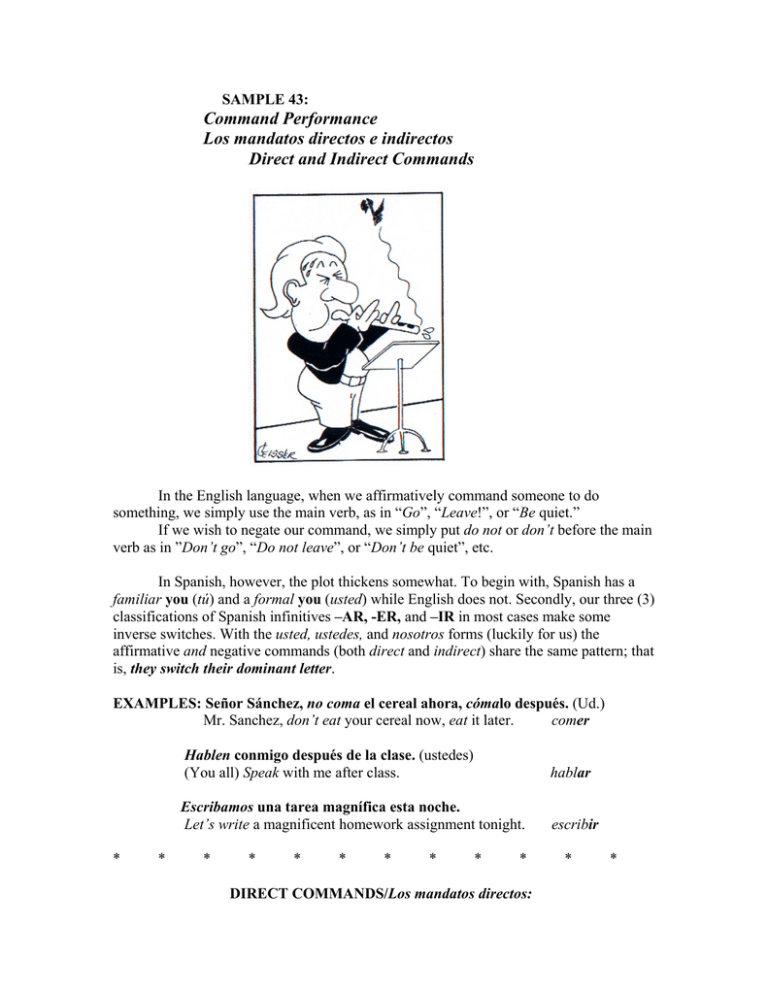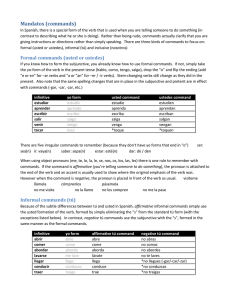Command Performance Los mandatos directos e indirectos Direct
Anuncio

SAMPLE 43: Command Performance Los mandatos directos e indirectos Direct and Indirect Commands In the English language, when we affirmatively command someone to do something, we simply use the main verb, as in “Go”, “Leave!”, or “Be quiet.” If we wish to negate our command, we simply put do not or don’t before the main verb as in ”Don’t go”, “Do not leave”, or “Don’t be quiet”, etc. In Spanish, however, the plot thickens somewhat. To begin with, Spanish has a familiar you (tú) and a formal you (usted) while English does not. Secondly, our three (3) classifications of Spanish infinitives –AR, -ER, and –IR in most cases make some inverse switches. With the usted, ustedes, and nosotros forms (luckily for us) the affirmative and negative commands (both direct and indirect) share the same pattern; that is, they switch their dominant letter. EXAMPLES: Señor Sánchez, no coma el cereal ahora, cómalo después. (Ud.) Mr. Sanchez, don’t eat your cereal now, eat it later. comer * * Hablen conmigo después de la clase. (ustedes) (You all) Speak with me after class. hablar Escribamos una tarea magnífica esta noche. Let’s write a magnificent homework assignment tonight. escribir * * * * * * * * DIRECT COMMANDS/Los mandatos directos: * * Ex: Go to the airport. USTED: (formal direct address) Affirmative Command: (Negative Command): vowel switch -AR > -e -ER/-IR > -a (No) Baile con ella. (Don’t) Dance with her. (No) Coma el cereal. (Don’t) Eat the cereal. bailar comer * * * * * * * * * * * USTEDES: (multiple person direct address) For the ustedes form, maintain the vowel switch but add the final –N: * vowel switch -AR > -en -ER/-IR > -an (No) Trabajen hoy. (No) Escriban la carta. (Don’t) Work today. (Don’t) Write the letter. trabajar escribir This is the final -n of plurality or multiplicity. * * * * * * * * * * * * NOSOTROS: (collective direct address, including myself) Now for the nosotros form, maintain the vowel switch but add the final –MOS: vowel switch -AR > -ER/-IR > -emos -amos (No) Estudiemos la lección. (No) Subamos al autobús. (Let’s not) Let’s study the lesson. (Let’s not) Let’s get on the bus. estudiar subir This is the final -mos of collectivity, which always includes the speaker “I”, yo. * * * * * * * * * * * * TÚ: (informal direct address) Simply drop the final –s off of the Simple Present conjugation of tú (i.e., lees > lee, trabajas > trabaja, piensas > piensa, etc.) for the Affirmative Direct command only! **AFFIRMATIVE DIRECT COMMANDS WITH TÚ** -AR -ER/-IR > > -a -e Baila con ella. Dance with her. Come el cereal. Eat the cereal. NOTE: No vowel switch is in place here. Also, the –s is removed with the tú form. Here are some irregular tú Affirmative Direct commands: venir salir ir ser to come to leave to go to be ven sal ve sé poner to put decir to say/totell tener to have hacer to do,to make Ven conmigo. Sal de la clase. Toma el cuaderno y ponlo en la mesa. pon di ten haz Come with me. Leave the class. Take the notebook and put it on the table. ** NEGATIVE DIRECT COMMANDS WITH TÚ** Vowel switch (with the final –s added). -AR -ER/-IR > > -es -as No bailes con ella. No comas el cereal. Don’t dance with her. Do not eat the cereal. This Negative Direct (tú) command is like using the usted form with an –s tacked on. Introduction to Indirect Commands: Excluding the tú form of Affirmative Direct commands as noted above in this sample chapter, in order to create Indirect Commands, simply place a QUE (that/have) before all of the other persons: yo, tú, usted, él, ella, nosotros, ustedes, and ellos. Then, make that vowel switch across the board. QUE = that or have (somebody do something) Audrey prefiere que tú lo hagas. Audrey prefers that you do it. El sacerdote exije que él asista a misa. The priest demands that he attend mass. Espero que llegue pronto la tranvía. I hope that the trolley arrive(s) soon. Insistimos en que no fumes en la iglesia. We insist that you not smoke in the church. Que busquen las cuevas en el mapa. Have them look for the caves on the map. INDIRECT COMMANDS/Los mandatos indirectos Ex: I prefer that you go to the airport. Indirect commands always require verbs of suäsion, persuasion, and dissuasion, generally encompassing two or three parties, requiring the Spanish Present (or Past) Subjunctive structures: Rena prefers that I leave; Loretta wanted me to cook, etc. DIRECT COMMAND: John, open your book and close it. INDIRECT COMMAND: John, I beg you to open your book and to close it. Fortunately, all persons (usted, ustedes, nosotros, including tú) make full use of that vowel switch, in both the Affirmative and Negative Indirect Commands. In other words, that troublesome tú form of the verb performs that previously mentioned vowel switch in both the Affirmative and Negative commands with Indirect Commands, along with all the other persons. So I repeat: the yo, tú, él, ella, usted, ustedes, ellos, ellas, and the nosotros verb forms all follow the same pattern in both the Affirmative and Negative commands with indirect commands using QUE (that/have). This means that all verbs make that vowel switch in Spanish with regular consistency. So only the tú form takes some thinking at this point, mainly with the Affirmative Direct command or the “do this” and “do that” form: toma (take), come (eat), escribe (write), etc. as opposed to its negations: no tomes, no comas, and no escribas (which do make that vowel switch). Mamá quiere que usted baile con ella. Mamá quiere que tú bailes con ella. Mom wants you to dance with her. Adrián insiste en que usted coma la cena. Adrián insiste en que tú comas la cena. Adrian insists that you eat dinner. Ruego que me escuchen. I beg them to listen to me. Jeanine espera que te duermas tú. Jeanine expects you to fall asleep. Queremos que salgas inmediatamente. We want you to leave immediately. Sugiero que bajemos por las escaleras. I suggest that we go down the stairs. Ricardo manda que no trabajes hoy. Richard commands that you not work today.
